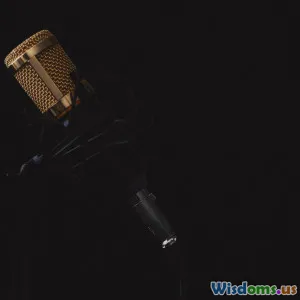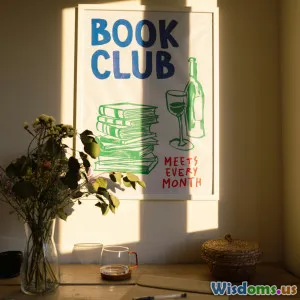
Inside the Banter Secrets of AwardWinning Comedy Radio Shows
8 min read Explore the insider secrets behind the dynamic banter that drives award-winning comedy radio shows, blending creativity, timing, and chemistry to captivate audiences. (0 Reviews)
Inside the Banter Secrets of Award-Winning Comedy Radio Shows
Introduction
If you’ve ever tuned into a top-tier comedy radio show and found yourself chuckling nonstop, you’ve experienced the magic of expert banter. But what exactly makes the back-and-forth between radio hosts not just funny, but award-winning? It’s more than just swapping jokes—it's an intricate dance of timing, chemistry, wit, and improvisation that few truly master. This article unravels the secrets behind what propels comedy radio banter from entertaining chatter to iconic, show-winning moments.
The Anatomy of Banter in Comedy Radio
Before diving into the secrets, it's essential to understand what banter means in the context of comedy radio. Banter often refers to spontaneous, witty dialogue — a dynamic exchange where hosts riff off each other's cues to generate laughter. But effective banter goes beyond rapid-fire jokes; it’s a combination of several core elements:
1. Timing and Rhythm
Comedy is famously about timing. In radio banter, this timing manifests as knowing when to interject, pause, or escalate a joke. Too fast, and the joke might get lost; too slow, and it undercuts energy.
For instance, The Chris Moyles Show on Radio X is renowned for its rhythmic conversational flow. Moyles and his co-hosts rely heavily on natural cadence, often debated in media psychology as a crucial component to audience retention and engagement. According to Nielsen Streaming Radio Ratings, shows with tighter rhythm in conversation spend more time in top 10 listener rankings.
2. Chemistry Among Hosts
One of the most observed factors in award-winning shows is the natural rapport between presenters. When hosts genuinely enjoy interacting, their banter feels authentic rather than scripted.
Consider The Ed and Geoff Show, which won several British Comedy Awards. Their off-screen friendship translated into spontaneous humor on-air — turning small unscripted moments into audience favorites. Their listeners commonly cite “the genuine connection” as a keystone of their appeal.
3. Improvisation Skills
While some radio shows prepare extensively, the best banter often comes from thinking on your feet. Improvisation allows hosts to create humor unique to unexpected topics or guest interactions.
The NPR show Wait Wait... Don’t Tell Me! showcases improvisation with its panelists seamlessly mixing topical news wit with ad-libbed remarks, crafting a humor landscape that never feels stale.
Crafting Award-Winning Banter: Behind the Scenes Techniques
Intentional Listening and Reacting
Great hosts do more listening than talking. By paying careful attention, they anticipate and respond in ways that feel natural. According to radio producer Jenna Martinez, this skill is honed through years of experience and awareness training.
In practice, if one host drops a subtle joke or uses a unique phrase, the others pick up and expand it, creating a layered humorous effect that rewards attentive audience members.
Scripted Frameworks with Spontaneous Delivery
Even in shows known for improvisation, many segments use frameworks or loose outlines to steer the conversation. This balance ensures the show maintains a pace while leaving ample room for free-form comedy.
For example, the Today Show's comedy radio break sessions feature main talking points but leave room for playful tangents. This hybrid approach captures both organization and spontaneity.
Use of Recurring Themes and Callbacks
Recurring jokes or references build familiarity and fan loyalty. Callbacks to previous on-air segments create an inside-joke atmosphere, deepening audience engagement.
Take The Howard Stern Show, famous for running character bits for months or even years, turning casual listeners into dedicated followers eager for “the next episode” of a running gag.
Integration of Audience Interaction
Live shows often incorporate listener calls and social media comments, adding an unpredictable layer to the banter. Hosts adept at weaving these elements maintain quick thinking and a versatile comedic approach.
A study by the Radio Society of Great Britain showed that shows utilizing real-time audience feedback typically experience a 15–20% boost in listener participation metrics.
Case Studies of Iconic Award-Winning Shows
1. The Breakfast Show with Zoe Ball
Awarded multiple Radio Academy Awards, Zoe Ball’s show exemplifies warmth and vibrancy in banter. Her ability to blend humor with empathy resonates widely, especially through candid conversations spiced with lighthearted teasing among her crew.
2. The Zach Sang Show
Popular in the U.S., this show thrives on banter between Zach and celebrity guests. Its success is attributed to Zach’s skillful mix of humor and genuine curiosity, breaking the stiff celebrity interview mold.
3. The Chris Moyles Show
Moyles’ knack for incorporating pop culture references and relentless energy has kept fans hooked for over a decade. His team’s chemistry and willingness to poke fun at themselves represent banter done right.
The Role of Technology and Evolving Platforms
Although traditional radio remains strong, many comedy shows leverage podcasts and streaming platforms, adapting banter styles for digital audiences.
Data from Edison Research shows podcast comedy genres have grown by 40% in listener numbers over five years, reflecting a rising appetite for conversational humor that feels personal and intimate.
Hosts now tailor their banter to suit different formats—more informal and candid in podcasts, more scripted and radio-friendly for broadcast—illustrating adaptability as a key to staying relevant.
Conclusion: Unlocking Laughter Through Masterful Banter
The secret to award-winning comedy radio banter lies in a multifaceted approach: unbreakable chemistry between hosts, impeccable timing, sharp improvisation, and a deep understanding of audience dynamics. These components combine to orchestrate a conversational goldmine that entertains listeners consistently.
Aspiring radio hosts and producers can learn from these insights by cultivating authentic relationships, maintaining flexible formats, and embracing spontaneity. For audiences, discovering the layers behind favorite comedic exchanges adds a richer appreciation for the art of radio comedy. In a media landscape crowded with options, it is this masterclass in banter that continues to elevate comedy radio into the realm of timeless entertainment.
Rate the Post
User Reviews
Popular Posts




















